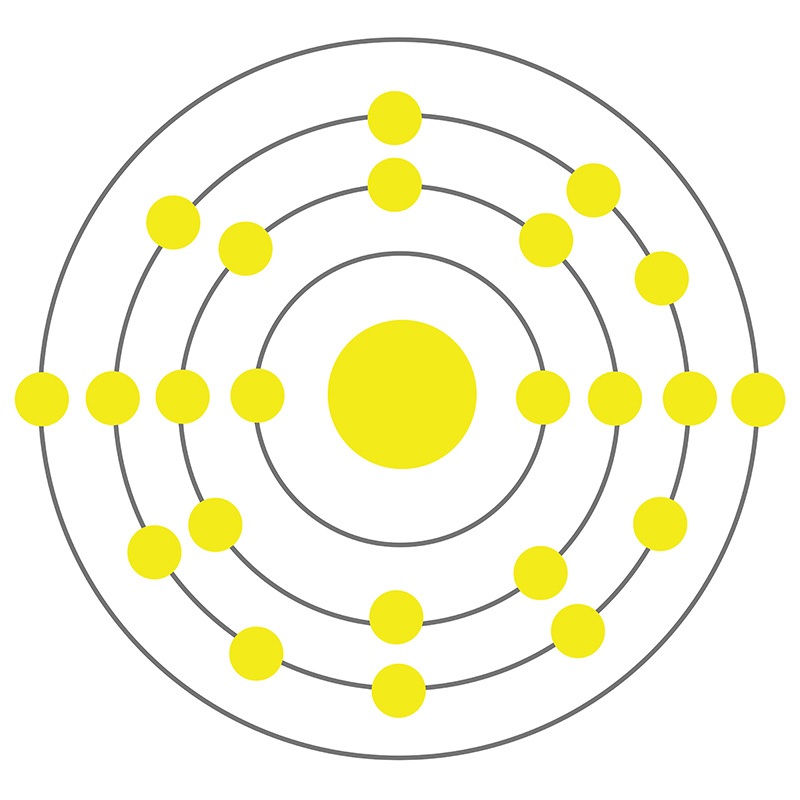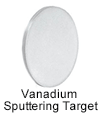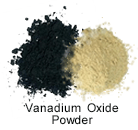About Vanadium

Vanadium is a d-block transition metal that exists in nature in multiple oxidation states, each of which imparts a distinctive color to its salts: purple/lavender/violet (+2), green (+3), blue (+4), and yellow (+5). This brilliance of these colors inspired Swedish chemist Nils Gabriel Selfström to name the new element he had isolated from a sample of wrought iron after Vanadis, another name for Freyja, the Norse goddess of beauty, love, and fertility. However, Selfström’s 1830 experiment does not mark the element’s first discovery; 29 years earlier in Mexico, Spanish mineralogist Andrés Manuel del Río had isolated numerous compounds from a sample of a mineral he termed “brown lead” (later renamed vanadinite) and determined that they contained a new element he named panchromium, for multi-colored, and later renamed to erythronium, Greek for “red,” after the red color the compounds took when heated. However, upon sharing his results with the Academie des Sciences de Paris, he was advised that he had merely produced an impure form of chromium. After attempts to obtain the metal by Berzelius and Wohler, and Henry Roscoe succeeded in 1867 by reducing the chloride with hydrogen. Industrial applications of vanadium compounds were limited to use as catalysts for the production of pigments and as mordants in dyeing printing fabrics until 1900, when Henry Ford employed vanadium steel in the production of the Model T.
Natural vanadium is composed of two isotopes, one stable (51V) and one radioactive (50V) and is the fifth most abundant transition metal in the earth’s crust, though it does not occur freely. The most common mineral sources of vanadium are vanadinite, carnotite and patronite, but it can also be found in over 65 different minerals including ores of titanium, uranium, and iron, phosphate rocks, and fossil fuel deposits such as crude and shale oils in the form of organic complexes. Vanadium pentoxide is the most common form of the element obtained; the metal is more difficult to produce due to its high reactive at the melting point of its oxide. Methods of obtaining high purity vanadium include reduction of its chloride with magnesium under an inert gas atmosphere and calcium reduction of the oxide in a pressure vessel. Metallic vanadium is ductile and malleable with a shiny gray appearance and is occasionally classified as a refractory metal owing to its high melting point and resistance to corrosion. The metal possesses a relatively low density and medium hardness and resists oxidation and attack by alkalis and most acids at temperatures lower than 600 C.
Its thermal and electrical conductivity and strength is superior to that of titanium, and the majority of its commercial use (~92%) is in the production of alloys. Adding even a small amount of vanadium to steel dramatically increases its tensile strength and hardness, in addition to providing shock and vibration resistance; vanadium steel, also referred to as “tool steel” or “high-speed steel,” is one of the strongest alloys used in armor plates, piston rods, jet engines, cutting tools, and other equipment parts. Vanadium steel is also used in the cores of nuclear reactors due to its resistance to corrosion and high temperatures in addition to vanadium’s excellent thermal neutron-capture cross-section. Ferrovanadium is a similarly strong, shock resistant and corrosion resistant iron alloy produced by reduction of vanadium pentoxide by aluminum or silicon in the presence of iron under an electric arc furnace. Ferrovanadium melts more easily than pure vanadium, and is often used as a master alloy to be added to steel before casting. Common nonferrous vanadium alloys include Titanium 6AL-4V used in aircraft and dental alloys (owing to the natural antibacterial properties of titanium); vanadium foil is also used to clad titanium to steel. Vanadium-silicon (V3Si) is classified as an A15-phase compound, an intermetallic crystalline compound composed of a transition metal (“A”) and any other element (“B”) with the formula A3B; V3Si was the first such compound discovered to exhibit superconductivity in 1953. Additionally, mixing vanadium and gallium in the ratio V3Ga yields a superconducting alloy used in the coils of superconducting electromagnets, either in the form of a wire or tape.
The most commercially significant form of vanadium is vanadium pentoxide. It is primarily used is in the production of ferrovanadium and as an industrial catalyst for the production of sulfuring acid; it can as function as a mordant or a ceramic pigment. Compounds that contain vanadium in a (+5) oxidation state are used as oxidizing agents in chemical reactions, whereas vanadium(2+) compounds are used as reducing agents. The pentoxide and ammonium metavanadate are both excellent oxidation employed by the chemical industry to produce sulfuric acid, synthetic plastics, and other organic compounds. Some vanadium compounds have applications in the field of medicine such as treatments for diabetes mellitus and nutritional supplements; the isotope 51V is used in nuclear magnetic resonance spectroscopy (NMR spectroscopy). However, all vanadium compounds are considered toxic to humans to some degree, particularly those with vanadium in a higher valence state. Trace amounts of the element exist in foods, the major source of exposure to the general public, but powdered forms of vanadium compounds are particularly hazardous due to the danger of inhalation and the ease with which the lungs absorb soluble vanadium salts.
The role of vanadium in advanced and emerging technologies is increasing due to the unique properties of its compounds. In particular, vanadium redox (or flow) batteries have gained attention in recent years as viable alternatives to the dominant lithium-ion technology currently in use. These rechargeable batteries store energy via continuously recyclable aqueous solutions of vanadium redox couples in both electrodes, eliminating the risk of cross-contamination of the electrolyte and yielding a low cost, high-efficiency energy source that has been investigated for potential use in hybrid and electric vehicles. Two-dimensional nanosheets of vanadium pentoxide have demonstrated favorable properties that could lead to their use as electrodes in supercapacitors. Vanadium dioxide has also gained attention for its unique properties. It is one of the few known materials that undergoes a metal-insulator transition: acting as an insulator at low temperatures, the material rearranges its electrons in an abrupt shift (taking only 10-trillionth of a second) to act like a conductor at 67 degrees Celsius. At 65 degrees, it enters a solid-state triple point--the first material in which researchers have ever accurately pinpointed. Some experiments into the uses of vanadium dioxide include the work of researchers at the Lawrence Berkeley National Laboratory, who used vanadium dioxide to fabricate a micro-sized artificial muscle-motor that exhibited extremely high power density and resilience. Thin ribbons of vanadium dioxide alternating with graphene have shown to be a highly efficient cathode material for lithium-ion batteries that could significantly increase power and energy density, and it has also been investigated as a metamaterial.
Products
Vanadium is highly resistant to corrosion, and thus is commonly added to stainless steel alloys. Vanadium compounds are used in advanced ceramics.  Vanadium's most important compound, vanadium pentoxide, is used as a catalyst for the production of sulfuric acid. Vanadium is available as metal and compounds with purities from 99% to 99.999% (ACS grade to ultra-high purity).
Vanadium's most important compound, vanadium pentoxide, is used as a catalyst for the production of sulfuric acid. Vanadium is available as metal and compounds with purities from 99% to 99.999% (ACS grade to ultra-high purity).  Elemental or metallic forms include pellets, rod, wire and granules for evaporation source material purposes. Vanadium nanoparticles and nanopowders provide ultra-high surface area. Oxides are available in powder and dense pellet form for such uses as optical coating and thin film applications. Oxides tend to be insoluble. Vanadium fluorides are another insoluble form for uses in which oxygen is undesirable such as metallurgy, chemical and physical vapor deposition and in some optical coatings. Vanadium is also available in soluble forms including chlorides and acetates. These compounds can be manufactured as solutions at specified stoichiometries.
Elemental or metallic forms include pellets, rod, wire and granules for evaporation source material purposes. Vanadium nanoparticles and nanopowders provide ultra-high surface area. Oxides are available in powder and dense pellet form for such uses as optical coating and thin film applications. Oxides tend to be insoluble. Vanadium fluorides are another insoluble form for uses in which oxygen is undesirable such as metallurgy, chemical and physical vapor deposition and in some optical coatings. Vanadium is also available in soluble forms including chlorides and acetates. These compounds can be manufactured as solutions at specified stoichiometries.
Vanadium Properties
 Vanadium is a Block D, Group 5, Period 4 element.
Vanadium is a Block D, Group 5, Period 4 element.  vanadium chloride (VCl3). Vanadium was named after "Vanadis" the goddess of beauty in Scandinavian mythology.
vanadium chloride (VCl3). Vanadium was named after "Vanadis" the goddess of beauty in Scandinavian mythology.
Health, Safety & Transportation Information for Vanadium
Several vanadium compounds are toxic to some creatures despite the fact that it is an essential trace element. Safety data for Vanadium and its compounds can vary widely depending on the form. For potential hazard information, toxicity, and road, sea and air transportation limitations, such as DOT Hazard Class, DOT Number, EU Number, NFPA Health rating and RTECS Class, please see the specific material or compound referenced in the Products tab. The below information applies to elemental (metallic) Vanadium.
| Safety Data | |
|---|---|
| Signal Word | N/A |
| Hazard Statements | N/A |
| Hazard Codes | N/A |
| Risk Codes | N/A |
| Safety Precautions | N/A |
| RTECS Number | YW1355000 |
| Transport Information | N/A |
| WGK Germany | nwg |
| Globally Harmonized System of Classification and Labelling (GHS) |
N/A |
Vanadium Isotopes
Naturally occurring vanadium is composed of one stable isotope 51V and one radioactive isotope 50V.
| Nuclide | Isotopic Mass | Half-Life | Mode of Decay | Nuclear Spin | Magnetic Moment | Binding Energy (MeV) | Natural Abundance (% by atom) |
|---|---|---|---|---|---|---|---|
| 40V | 40.01109(54)# | N/A | p to 40Ti | 2-# | N/A | 287.09 | - |
| 41V | 40.99978(22)# | N/A | p to 41Ti | 7/2-# | N/A | 306.35 | - |
| 42V | 41.99123(21)# | <55 ns | p to 42Ti | 2-# | N/A | 321.88 | - |
| 43V | 42.98065(25)# | 80# ms | ß+ to 43Ti | 7/2-# | N/A | 340.21 | - |
| 44V | 43.97411(13) | 111(7) ms | ß+ to 44Ti; a to 40Sc | (2+) | N/A | 353.88 | - |
| 45V | 44.965776(18) | 547(6) ms | ß+ to 45Ti | 7/2- | N/A | 370.34 | - |
| 46V | 45.9602005(11) | 422.50(11) ms | ß+ to 46Ti | 0+ | N/A | 383.08 | - |
| 47V | 46.9549089(9) | 32.6(3) min | EC to 47Ti | 3/2- | N/A | 396.75 | - |
| 48V | 47.9522537(27) | 15.9735(25) d | EC to 48Ti | 4+ | 2.01 | 406.69 | - |
| 49V | 48.9485161(12) | 329(3) d | EC to 49Ti | 7/2- | 4.47 | 418.49 | - |
| 50V | 49.9471585(11) | 1.4 x 1017 y | ß+ to 50Ti; ß- to 50Cr | 6+ | 3.34745 | 427.5 | 0.25 |
| 51V | 50.9439595(11) | STABLE | - | 7/2- | 5.1514 | 439.31 | 99.75 |
| 52V | 51.9447755(11) | 3.743(5) min | ß- to 52Cr | 3+ | N/A | 446.46 | - |
| 53V | 52.944338(3) | 1.60(4) min | ß- to 53Cr | 7/2- | N/A | 454.54 | - |
| 54V | 53.946440(16) | 49.8(5) s | ß- to 54Cr | 3+ | N/A | 460.75 | - |
| 55V | 54.94723(11) | 6.54(15) s | ß- to 55Cr | (7/2-)# | N/A | 467.9 | - |
| 56V | 55.95053(22) | 216(4) ms | ß- to 56Cr; ß- + n to 55Cr | (1+) | N/A | 473.18 | - |
| 57V | 56.95256(25) | 0.35(1) s | ß- to 57Cr; ß- + n to 56Cr | (3/2-) | N/A | 479.4 | - |
| 58V | 57.95683(27) | 191(8) ms | ß- to 58Cr; ß- + n to 57Cr | 3+# | N/A | 483.75 | - |
| 59V | 58.96021(33) | 75(7) ms | ß- to 59Cr; ß- + n to 58Cr | 7/2-# | N/A | 488.1 | - |
| 60V | 59.96503(51) | 122(18) ms | ß- to 60Cr; ß- + n to 59Cr | 3+# | N/A | 491.52 | - |
| 61V | 60.96848(43)# | 47.0(12) ms | ß- to 61Cr | 7/2-# | N/A | 496.81 | - |
| 62V | 61.97378(54)# | 33.5(20) ms | ß- to 62Cr | 3+# | N/A | 500.23 | - |
| 63V | 62.97755(64)# | 17(3) ms | ß- to 63Cr | (7/2-)# | N/A | 504.58 | - |
| 64V | 63.98347(75)# | 10# ms [>300 ns] | Unknown | N/A | N/A | 507.07 | - |
| 65V | 64.98792(86)# | 10# ms | Unknown | 5/2-# | N/A | 511.42 | - |